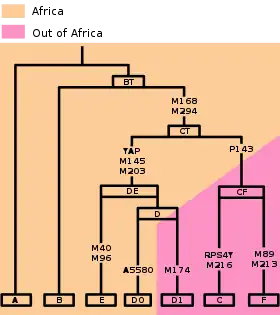| Haplogroup BT | |
|---|---|
 | |
| Possible time of origin | about 150-145,000 years ago[1] |
| Possible place of origin | Africa[2] |
| Ancestor | A2-T |
| Descendants | B-M60, CT |
| Defining mutations | Page65.1/SRY1532.1/SRY10831.1, M42, M91, M94, M139, M299, P97, V21, V29, V31, V59, V64, V102, V187, V202, V216, V235 |
Haplogroup BT M91, also known as Haplogroup A1b2 (and formerly as A4, BR and BCDEF), is a Y-chromosome haplogroup. BT is a subclade of haplogroup A1b (P108) and a sibling of the haplogroup A1b1 (L419/PF712).[2]
Distribution
Basal BT* has not been documented in any living individuals or ancient remains. Later Stone Age individuals excavated at Fingira Rock, Malawi, dated to around 6100 years ago (2/2 males), and at Mount Hora, Malawi, dated to around 8000 years ago (1/1 males), all belonged to Y haplogroup BT(xCT)[3] (i.e. they did not belong to haplogroup CT but may have belonged to haplogroup B).
No definite examples of BT(xCF,DE) – i.e. members of BT outside the only two known branches of CT, namely haplogroups CF and DE – have been identified. In some cases, because testing is undertaken only for geographically and historically likely haplogroups, the data required to identify a precise subclade has not been collected and/or recorded. For instance, research published in 2013, regarding a sample of more than 2,000 men from different parts of Africa, included 7.5% belonging to haplogroup BT(xDE,K).[4] These approximately 150 individuals may have included, for example: B*, unknown primary branches of haplogroups B, BT, CT or CF; haplogroup C, and/or; F(xK) (i.e. haplogroup F* plus its subclades G, H and IJ, but specifically excluding the broader haplogroup K and its subclades, such as haplogroups K*, LT, K2b*, MS, NO, P, Q and R).
Phylogenetics
The ISOGG tree since 2014 has treated M91 as the defining mutation of BT.[5]
Prior to 2002, there were in academic literature at least seven naming systems for the Y-Chromosome Phylogenetic tree. This led to considerable confusion. In 2002, the major research groups came together and formed the Y-Chromosome Consortium (YCC). They published a joint paper that created a single new tree that all agreed to use.

See also
- Conversion table for Y chromosome haplogroups
- Genetic genealogy
- Haplogroup D (Y-DNA)
- Haplogroup DE (Y-DNA)
- Haplogroup
- Haplotype
- Human Y-chromosome DNA haplogroup
- Molecular phylogenetics
- Paragroup
- Subclade
- Y-chromosome haplogroups in populations of the world
- Y-DNA haplogroups by ethnic group
- Y-DNA haplogroups in populations of Sub-Saharan Africa
References
- ↑ Kamin M, Saag L, Vincente M, et al. (April 2015). "A recent bottleneck of Y chromosome diversity coincides with a global change in culture". Genome Research. 25 (4): 459–466. doi:10.1101/gr.186684.114. PMC 4381518. PMID 25770088.
- 1 2 Cruciani, Fulvio; Trombetta, Beniamino; Massaia, Andrea; Destro-Bisol, Giovanni; Sellitto, Daniele; Scozzari, Rosaria (2011). "A Revised Root for the Human y Chromosomal Phylogenetic Tree: The Origin of Patrilineal Diversity in Africa". The American Journal of Human Genetics. 88 (6): 814–818. doi:10.1016/j.ajhg.2011.05.002. PMC 3113241. PMID 21601174.
- ↑ Skoglund, Pontus; Thompson, Jessica C; Prendergast, Mary E; Mittnik, Alissa; Sirak, Kendra; Hajdinjak, Mateja; Salie, Tasneem; Rohland, Nadin; Mallick, Swapan; Peltzer, Alexander; Heinze, Anja; Olalde, Iñigo; Ferry, Matthew; Harney, Eadaoin; Michel, Megan; Stewardson, Kristin; Cerezo-Román, Jessica I; Chiumia, Chrissy; Crowther, Alison; Gomani-Chindebvu, Elizabeth; Gidna, Agness O; Grillo, Katherine M; Helenius, I. Taneli; Hellenthal, Garrett; Helm, Richard; Horton, Mark; López, Saioa; Mabulla, Audax Z.P; Parkington, John; et al. (2017). "Reconstructing Prehistoric African Population Structure". Cell. 171 (1): 59–71.e21. doi:10.1016/j.cell.2017.08.049. PMC 5679310. PMID 28938123.
- ↑ Ansari Pour, Naser; Plaster, Christopher; Bradman, Neil (2013). "Evidence from Y-chromosome analysis for a late exclusively eastern expansion of the Bantu-speaking people". European Journal of Human Genetics. 21 (4): 423–429. doi:10.1038/ejhg.2012.176. PMC 3598330. PMID 22892538.
- ↑ Y-DNA Haplogroup A and its Subclades - 2012 (BT as subclade of A1b-P108) Y-DNA Haplogroup A and its Subclades - 2014 (BT as subclade of A1b-P108); Y-DNA Haplogroup Tree 2015 (BT-M91 listed as subclade of A1a-M31). ISOGG has listed M42 as a mutation characteristic (but not defining) of BT since 2012.
- ↑ ISOGG Haplogroup A (2012): "BT is shown on this tree, though it is not considered to be a part of Haplogroup A, in order to make it clear that, as a sibling clade of A1b1, BT and all other haplogroups are downstream of A1b. Listed 15 February 2012." (also note that the group labelled "A1b" in the image is the "A0" of ISOGG (2012)).